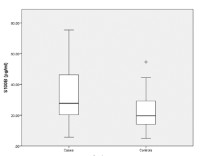Association of Serum S100b with Prognostic Factors in Acute Ischemic Stroke Patients at the Obafemi Awolowo University Teaching Hospitals Complex, Ile-Ife, Nigeria
DOI:
https://doi.org/10.60787/tnhj.v23i4.753Keywords:
Stroke, Brain ischemia, NIHSS: National institute of Health Stroke Scale, mRS: modified Rankin Score, BiomarkersAbstract
Background: Stroke is a life-threatening neurological condition due to impairment in blood supply to the brain. In addition to clinical acumen, diagnosis and monitoring of stroke requires technical radiological imaging procedures. Researchers have sought serum biomarkers to aid the diagnosis and monitoring of stroke patients.
Method: Serum S100B was measured in 33 patients with acute ischemic stroke to evaluate its relationship with prognostic factors in stroke: severity estimated with the National Institute of Health Stroke Scale (NIHSS), functional outcome evaluated using the modified Rankin score (mRS), and infarct volume on computed tomography (CT) scan.
Background: Stroke is a life-threatening neurological condition due to impairment in blood supply to the brain. In addition to clinical acumen, diagnosis and monitoring of stroke requires technical radiological imaging procedures. Researchers have sought serum biomarkers to aid the diagnosis and monitoring of stroke patients.
Method: Serum S100B was measured in 33 patients with acute ischemic stroke to evaluate its relationship with prognostic factors in stroke: severity estimated with the National Institute of Health Stroke Scale (NIHSS), functional outcome evaluated using the modified Rankin score (mRS), and infarct volume on computed tomography (CT) scan.
Result: A population of 33 test subjects with stroke were recruited into the study together with apparently healthy age and gender matched control subjects. S100B was assayed in all the participants with an Enzyme Linked Immuno-Sorbent Assay method (ELISA). The stroke patients were assigned NIHSS scores; functional outcome was assessed using the mRS. Infarct volume on CT scan was measured with the scanner volumetry program.
Conclusion: Elevated serum S100B is associated with increased clinical severity in acute ischemic stroke patients. S100B may thus be a suitable biomarker for monitoring patients with ischemic stroke.
Result: A population of 33 test subjects with stroke were recruited into the study together with apparently healthy age and gender matched control subjects. S100B was assayed in all the participants with an Enzyme Linked Immuno-Sorbent Assay method (ELISA). The stroke patients were assigned NIHSS scores; functional outcome was assessed using the mRS. Infarct volume on CT scan was measured with the scanner volumetry program.
Conclusion: Elevated serum S100B is associated with increased clinical severity in acute ischemic stroke patients. S100B may thus be a suitable biomarker for monitoring patients with ischemic stroke.
Downloads
References
Sacco RL, Kasner SE, Broderick JP, Caplan LR, Connors JJJ, Culebras A, et al. (2013). An updated definition of stroke for the 21st century: A statement for healthcare professionals from the American heart association/American stroke association. Stroke. 44(7):2064–89.
Boehme AK, Esenwa C, Elkind MS V. (2017). Stroke Risk Factors, Genetics, and Prevention. Circ Res. 120(3):472–95.
Feigin VL, Forouzanfar MH, Krishnamurthi R, Mensah GA, Connor M, Bennett DA, et al. (2010). Global and regional burden of stroke during 1990-2010: findings from the Global Burden of Disease Study Lancet. 383(9913):245–54.
Sanya EO, Desalu OO, Adepoju F, Aderibigbe SA, Shittu A, Olaosebikan O. (2015). Prevalence of stroke in three semi-urban communities in middle-belt region of Nigeria: A door to door survey. Pan Afr Med J. 20:1–8.
Saenger AK, Christenson RH. (2010). Stroke biomarkers: Progress and challenges for diagnosis, prognosis, differentiation, and treatment. Clin Chem. 56(1):21–33.
Reynolds MA, Kirchick HJ, Dahlen JR, Anderberg JM, McPherson PH, Nakamura KK, et al.(2013). Early biomarkers of stroke. Clin Chem. 49(10):1733–9.
Kim MH, Kang SY, Kim MC, Lee WI. (2010). Plasma biomarkers in the diagnosis of acute ischemic stroke. Ann Clin Lab Sci. 40(4):336–41.
Jickling GC, Sharp FR. (2011). Blood Biomarkers of Ischemic Stroke. Neurotherapeutics. 8(3):349–60.
Guo YW, Li PY, Guo QL, Shang KX, Yan D, Du SY, et al. (2013). Pathophysiology and Biomarkers in Acute Ischemic Stroke - A Review. Trop J Pharm Res. 12(6):1097–105.
Moore BW. (1965) A soluble protein characteristic of the nervous system. Biochem Biophys Res Commun [Internet]. 19(6):739–44. Available from: https://www.sciencedirect.com/science/article/pii/0006291X65903207.
Kligman D, Hilt DC. (1988) The S100 protein family. Trends in biochemical sciences. 13(11), 437–443. https://doi.org/10.1016/0968-0004(88)90218-6
Heizmann CW, Fritz G, Schäfer BW. (2002). S100 proteins: Structure, functions, and pathology. Frontiers in Bioscience. (2):1356–68.
Raabe A, Kopetsch O, Groß U, Zimmermann M, Gebhart P. (2003). Measurements of Serum S-100B Protein : Effects of Storage Time and Temperature on Pre-Analytical Stability. Clinical chemistry and laboratory medicine. 41(5):700–3.
Rohlwink UK, Figaji AA. Biomarkers of brain injury in cerebral infections. Clin Chem. 2014;60(6):823–34.
Gaynor R, Irie R, Morton D, Herschman HR. (1980) S100 protein is present in cultured human malignant melanomas. Nature. 286(5771):400–1. Available from: https://doi.org/10.1038/286400a0.
Gaynor R, Herschman HR, Irie R, Jones P, Morton D, Cochran A. (1981). S100 protein: a marker for human malignant melanomas? Lancet. 1(8225):869–71.
Jo H, Alling C, Westaby S, Blomquist S. (2001). S100B as a Predictor of Size and Outcome of Stroke. 4975(00):3–7.
Abdel-Ghaffar EW, Ahmed S, Mahmoud E, Amr E, Mona E, Doaa H. (2019). The role of s100b as a predictor of the functional outcome in geriatric patients with acute cerebrovascular stroke. Egypt J Neurol Psychiatry Neurosurg 55, 75. https://doi.org/10.1186/s41983-019-0105-8.
Selçuk Ö, Yayla V, Çabalar M, Güzel V, Uysal S, Gedikbaşi A. (2014). The relationship of serum s100b levels with infarction size and clinical outcome in acute ischemic stroke patients. Noropsikiyatri Ars. 51(4):395–400.
Onatsu J, Vanninen R, JÄkÄlÄ P, Mustonen, P., Pulkki, K., Korhonen, M. et al. (2020). Tau, S100B and NSE as Blood Biomarkers in Acute Cerebrovascular Events. In Vivo. 34(5):2577-2586. doi:10.21873/invivo.12075.
Kumar H, Lakhotia M, Pahadiya H, Singh J. (2015). To study the correlation of serum S-100 protein level with the severity of stroke and its prognostic implication. J Neurosci Rural Pract. 6(3):326–30.
Missler U, Wiesmann M, Friedrich C, Kaps M. (1997) S-100 protein and neuron-specific enolase concentrations in blood as indicators of infarction volume and prognosis in acute ischemic stroke. Stroke. 28(10):1956–60.
Park SY, Kim MH, Kim OJ, Ahn HJ, Song JY, Jeong JY, et al. (2013).Plasma heart-type fatty acid binding protein level in acute ischemic stroke: Comparative analysis with plasma S100B level for diagnosis of stroke and prediction of long-term clinical outcome. Clin Neurol Neurosurg [Internet]. 115(4):405–10. Available from: http://dx.doi.org/10.1016/j.clineuro.2012.06.004.
Manole C, Minerva G, Mihaela CI, Violeta Ş, Mircea G. (2012). Increased serum s100 proteins in patients with acute ischemic stroke; relationship to clinical outcome. Med Con. 7(1) 45–7.
Herrmann M, Vos P, Wunderlich MT, de Bruijn CHMM, Lamers KJB. (2000) Release of Tissue–Specific Proteins After Acute Stroke. Stroke. 31(11):2670–7.
Wunderlich MT, Ebert AD, Kratz T, Goertler M, Jost S, Herrmann M. (1999). Early Neurobehavioral Outcome After Stroke Is Related to Release of Neurobiochemical Markers of Brain Damage. Stroke. 30(60):1190-1195.
Wunderlich MT, Wallesch C, Goertler M. (2024). Release of neurobiochemical markers of brain damage is related to the neurovascular status on admission and the site of arterial occlusion in acute ischemic stroke. Journal of the neurological sciences. 227:49–53.
Bielewicz JE, Kurzepa J, Kamieniak P, Daniluk B, Szczepańska-szerej A, Rejdak K.(2020). Clinical and biochemical predictors of late-outcome in patients after ischemic stroke. Annals of agricultural and environmental medicine. 27(2):290–4.
Foerch C, Singer OC, Neumann-Haefelin T, du Mesnil de Rochemont R, Steinmetz H, Sitzer M.(2005). Evaluation of serum S100B as a surrogate marker for long-term outcome and infarct volume in acute middle cerebral artery infarction. Arch Neurol. 62(7):1130-1134. doi:10.1001/archneur.62.7.1130.

Published
Issue
Section
License
Copyright (c) 2023 Journal and Publisher

This work is licensed under a Creative Commons Attribution-NonCommercial-NoDerivatives 4.0 International License.
The Journal is owned, published and copyrighted by the Nigerian Medical Association, River state Branch. The copyright of papers published are vested in the journal and the publisher. In line with our open access policy and the Creative Commons Attribution License policy authors are allowed to share their work with an acknowledgement of the work's authorship and initial publication in this journal.
This is an open access journal which means that all content is freely available without charge to the user or his/her institution. Users are allowed to read, download, copy, distribute, print, search, or link to the full texts of the articles in this journal without asking prior permission from the publisher or the author.
The use of general descriptive names, trade names, trademarks, and so forth in this publication, even if not specifically identified, does not imply that these names are not protected by the relevant laws and regulations. While the advice and information in this journal are believed to be true and accurate on the date of its going to press, neither the authors, the editors, nor the publisher can accept any legal responsibility for any errors or omissions that may be made. The publisher makes no warranty, express or implied, with respect to the material contained herein.
TNHJ also supports open access archiving of articles published in the journal after three months of publication. Authors are permitted and encouraged to post their work online (e.g, in institutional repositories or on their website) within the stated period, as it can lead to productive exchanges, as well as earlier and greater citation of published work (See The Effect of Open Access). All requests for permission for open access archiving outside this period should be sent to the editor via email to editor@tnhjph.com.





